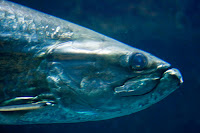It may look nothing like an eel, but the Atlantic tarpon is related to these ancient snakelike fish. The evidence of this is to be found by looking at the tarpon’s newly hatched young.
Both eels and tarpon lay eggs. These bring forth out into ribbonlike hatchlings (youthful stages) regarded as leptocephali. The likenesses among the larval stage of both the aforementioned species intend that there is undoubtedly they are related. However, they closely look like one another when completely grown.The leptocephali, which look truly contrasting from the adults,migrate to beachfront zones. There they finish their growth and transform into the grown-up shape.
This relationship between tarpon and eels has had a long time to develop.
Tarpon are known to have been around for about 130 million years, while the ancestors of today’s eels have an even longer history. However, they have evolved along separate lines, ending up with their own unique characteristics.
Tarpon are known to have been around for about 130 million years, while the ancestors of today’s eels have an even longer history. However, they have evolved along separate lines, ending up with their own unique characteristics.
In addition to breathing through their gills, tarpon can gulp in air at the water surface and pass it directl into their swim bladder.This acts as a lung and allows them to survive in areas where the oxygen content of the water is low. Despite this, tarpon require a lot of oxygen.Without it, they could not jump 10 feet vertically into the air, or 20 feet horizontally— something they do to escape danger.
Tarpon are able to generate great speed, and can grow very large and heavy—they weigh up to 350 pounds. They can cause serious injuries, or even death, to any human who is accidentally hit by one of these “flying” tarpons as it breaches the surface of the water.









0 comments:
Post a Comment